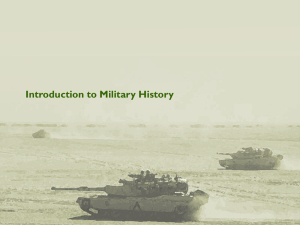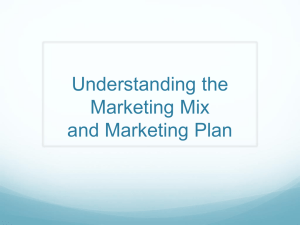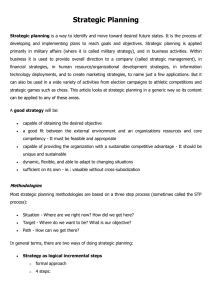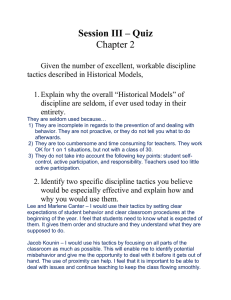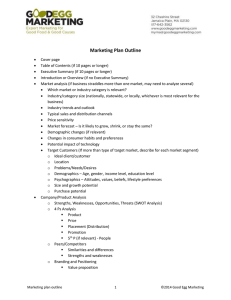Operations Strategy in a Global Environment Pertemuan 02
advertisement
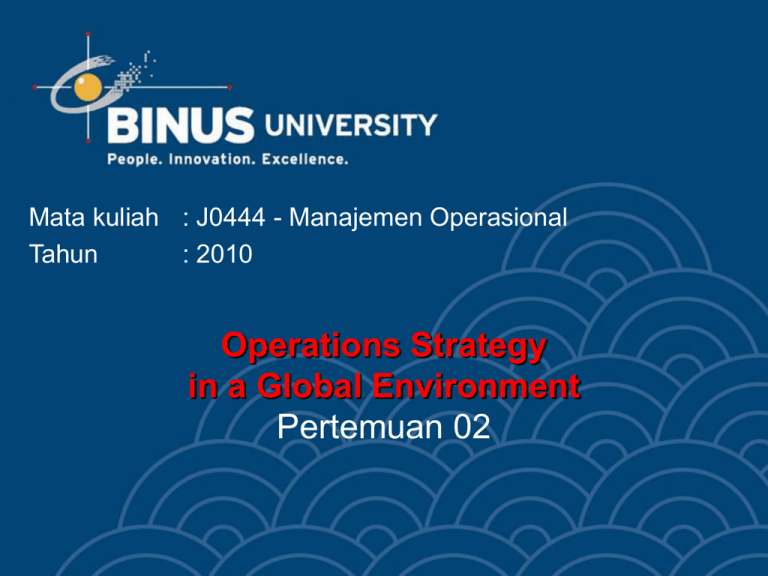
Mata kuliah : J0444 - Manajemen Operasional Tahun : 2010 Operations Strategy in a Global Environment Pertemuan 02 Learning Objectives Identify or Define: – Mission – Strategy – Multinational Corporations – Specific approaches used by OM to achieve strategies – Four Global Operations Strategies – Why Global Issues are Important Management Issues in Global Operations Global Strategic Context – Differentiation – Cost leadership – Response Supply Chain Manageme nt Location Decisions Logistics Manageme nt Supply-Chain Management • • • • Sourcing Vertical integration Make-or-buy decisions Partnering Location Decisions • • • • Country-related issues Product-related issues Government policy/political risk Organizational issues Materials Management • • • • • Flow of materials Transportation options and speed Inventory levels Packaging Storage Defining Global Operations • International business - engages in cross-border transactions • Multinational Corporation - has extensive involvement in international business, owning or controlling facilities in more than one country • Global company - integrates operations from different countries, and views world as a single marketplace • Transnational company - seeks to combine the benefits of global-scale efficiencies with the benefits of local responsiveness Reasons to Globalize Operations Tangible Intangiblel • • • • • • Reduce costs (labor, taxes, tariffs, etc.) Improve the supply chain Provide better goods and services Attract new markets Learn to improve operations Attract and retain global talent Achieving Global Operations -Four Considerations• • • • Global product design Global process design and technology Global factory location analysis Impact of Culture and Ethics Global Product Design • Remember social and cultural differences – packaging and marketing can help make product seem “domestic” but • “liter” versus “quart” • “sweetness” and “taste” Global Process Design and Technology • Information technology enables management of integrated, globally dispersed operation • Texas Instruments: 50 plants in 19 countries • Hewlett-Packard - product development teams in U.S., Japan, Great Britain, and Germany • Reduces time-to-market Global Facility Location Analysis Using CSFs for Country Selection • Select CSFs based on parent organization;’s strategic or operations objectives • Obtain country-specific information on the CSFs • Evaluate each country’s CSFs using a 1 (bad) to 5 (good) rating scale • Sum the ratings You May Wish To Consider • • • • • • • • national literacy rate rate of innovation rate of technology change number of skilled workers stability of government product liability laws export restrictions similarity in language work ethic tax rates inflation availability of raw materials interest rates population number of miles of highway Global Impact of Culture and Ethics • Cultures differ! Some accept/expect: – variations in punctuality – long lunch hours – expectation of thievery – bribery – little protection of intellectual property To Establish Global Services • Determine if sufficient people or facilities exist to support the service • Identify foreign markets that are open - not controlled by governments • Determine what services are of most interest to foreign customers • Determine how to reach global customers Managing Global Service Operations Must take a different perspective on • Capacity planning • Location Planning • Facilities design and layout • Scheduling Some Definitions • International business – A firm that engages in cross-border transactions. • Multinational Corporation (MNC) – A firm that has extensive involvement in international business, owning or controlling facilities in more than one country Some Global Strategies • International Strategy: uses exports and licenses to penetrate the global area • Multidomestic Strategy: uses decentralized authority with substantial autonomy at each business Some Global Strategies • Global Strategy: Uses a high degree of centralization, with headquarters coordinating to seek standardization and learning between plants • Transnational Strategy: Exploits economies of scale and learning, as well as pressure for responsiveness, by recognizing that core competencies reside everywhere in the organization Why Some Organizations Fail • Too much emphasis on short-term financial performance • Failing to take advantage of strengths and opportunities • Neglecting operations strategy • Failing to recognize competitive threats Why Some Organizations Fail • Too much emphasis in product and service design and not enough on improvement • Neglecting investments in capital and human resources • Failing to establish good internal communications • Failing to consider customer wants and needs Mission/Strategy/Tactics Mission Strategy Tactics How does mission, strategies and tactics relate to decision making and distinctive competencies? Strategy • Mission – The reason for existence for an organization • Mission Statement – States the purpose of an organization • Goals – Provide • detail and scope of mission Strategies –Plans for achieving organizational goals • Tactics – The methods and actions taken to accomplish strategies Planning and Decision Making Mission Goals Organizational Strategies Functional Goals Finance Strategies Tactics Operating procedures Marketing Strategies Operations Strategies Tactics Tactics Operating procedures Operating procedures Strategy Example Rita is a high school student. She would like to have a career in business, have a good job, and earn enough income to live comfortably Mission: • Goal: • Strategy: • Tactics: • Operations: Live a good life Successful career, good income Obtain a college education Select a college and a major Register, buy books, take courses, study, graduate, get job Strategies for Competitive Advantage • Differentiation • Cost leadership • Quick response Competing on Differentiation Uniqueness can go beyond both the physical characteristics and service attributes to encompass everything that impacts customer’s perception of value Competing on Cost Provide the maximum value as perceived by customer Does not imply low value or low quality Competing on Response • Flexibility • Reliability • Timeliness Requires institutionalization within the firm of the ability to respond Four International Operations Strategies • Multidomestic Strategy Operating decisions are decentralized to each country to enhance local responsiveness • Global Strategy Operating decisions are centralized and headquarters coordinates the standardization and learning between facilities • Transnational Strategies Combines the benefits of global-scale efficiencies with the benefits of local responsiveness • International Strategy Global markets are penetrated using exports and licenses The End
